It’s safe to say that as production started on The Great Mouse Detective (1986), no one at Disney’s Animation Department was very happy. The Fox and the Hound had done decently, but not well enough to encourage Disney executives to send money to the animation department, especially since the conventional wisdom was that the glory days of Disney animation had died along with Walt Disney. Animation itself seemed more of a former craze, something relegated to kiddie cartoons on Saturday mornings—no matter what might be happening over in Japan. Disney itself was undergoing a major corporate shakeup, which left two executives with limited experience in animation—Michael Eisner as CEO and Jeffrey Katzenberg as the head of the film division—in charge of directing and approving future animated films. The Black Cauldron, released in the midst of this, was an artistic and financial disaster, exiling the entire animation department out of their nice animation studio and into a much less nice warehouse. The animation department could only watch the skyrocketing careers of two former Disney animators—Don Bluth and Tim Burton—with envy and dismay.
In a crowning touch, after seeing the storyboards for The Great Mouse Detective, Michael Eisner slashed the film’s budget in half.
This move was later given a remarkably kind spin by in house Disney historians and public relations people, who credited Eisner’s “courageous” budget cuts as the step that inspired Disney animators to develop new, cost effective methods of using computers to slash animation costs, but at the time, it was yet another discouraging moment.
The results of this can be seen in the finished film. The thick dark lines around characters are back, as are leftover pencil marks, and the occasional “shimmer” effect, admittedly just seen in The Black Cauldron, but before that, not since Snow White. Very few scenes featured more than one moving character, and in a couple of scenes the characters in front move while the characters in the back remain completely still, something Disney hadn’t done since Cinderella. It’s even more noticeable here, since in Cinderella an argument can be made that the background characters at the dance are remaining still out of respect for Prince Charming, or really are part of the background. Here, the characters in the back are mice drinking at a pub, or evil mice cheering on the defeat of hero mice Basil and Dr. Dawson, or mice terrified that their country is about to get taken over by a Very Evil Rat—er, that is, Mouse. All of these mice should be moving. They don’t.
That pub scene ended up causing other issues for Disney, since it features the hands down first show of, how can I put this, sex and legs in a Disney animated film, during the singing of a cabaret style song, voiced by an uncredited Melissa Manchester. It’s just mouse legs, but the Motion Picture Association of America (the MPAA) found the entire thing far too risqué for children’s entertainment, and nearly slapped a PG rating on the entire film. Disney had happily accepted the PG rating for The Black Cauldron—which was intended for older audiences—but balked on receiving a PG rating for a can-can dance performed by mice, even if one of the mice was ever so slightly under the influence and even if the other mice were definitely singing and dancing in a rather seductive sort of way. The MPAA was also not thrilled with another, separate scene showing a mouse under, shall we say, the influence. Very under the influence. After some discussion, and agreement that a scene that ends with the death of the rather drunk mouse in question could hardly be said to have a pro-alcohol message, the MPAA backed down, agreeing to give the film a G rating, a move that might well have earned/saved Disney millions.
(That’s about it for any offensiveness in this film, although very small children may find the villain Ratigan and his pet cat VERY SCARY since Felicia the cat—you should be warned—EATS CUTE MICE and ALMOST EATS A BAT. Bad mice and a scary bat, and all of this is offscreen, but still, MICE. Children older than four should be fine.)
That was not the only scene that ended up giving animators fits. The final great set piece—a chase scene through the great clockwork gears of Big Ben—was possible only thanks to a bit of computer generated imagery/computer assisted animation: the graphics for the gears were plotted into a computer, then printed out and traced, saving animators months of work. That part looks great. The rest of the film, not nearly as much, even with a cabaret dance; this is probably Disney’s worst looking film in decades, even filled, as it is, with generally adorable mice.
That the film works at all is almost entirely thanks to one piece of inspired casting: Vincent Price as the very very evil Ratigan. Price reveled in the sheer over the top evil of the role, and was reportedly delighted when, following Disney tradition, the animators even made Ratigan look a little like Vincent Price.
A few things to know about Ratigan: one, he might not actually be—gasp—a mouse. In fact I’m pretty sure he’s really a rat, with an odd fixation on the mouse world, but let us move on. Two, he has big plans—BIG PLANS. His grandiose plan includes kidnapping, an evil bat, a skilled toymaker, uniforms stolen from toy soldiers, a clockwork Queen Mousetoria that can impersonate the real Queen Mousetoria right down to her voice, some rather nasty ideas about eliminating mouse pensions (reportedly inspired both by some ongoing “discussions” with Eisner about benefits and Vincent Price’s “discussions” with industry executives during Filmways, Inc. takeover of American International Pictures in 1979) and TAKING OVER THE WORLD. It’s all awfully complicated, but you can’t accuse Ratigan of having no imagination. Or ambition. Or modesty: he sings an entire song about how great he is, and it’s so convincing that almost all of the listening mice agree. Ok, that’s partly because the one mouse that doesn’t agree immediately gets eaten by a rather spoiled cat, but I was convinced even before the cat started snacking.
Ratigan’s also not totally evil. I mean, ok, sure, he takes pride in killing off widows and orphans and terrorizing people and assault and robbery, but, in his defense, he plays the harp rather well and throws great parties. And can we really hate a villain who loves his pet cat so much that he carefully feeds her all of his tastiest henchmen, not to mention a genuinely royal treat—Queen Mousteria herself? I think not. It’s both kind—well, to the cat—and efficient—well, in the sense of effectively terrorizing the rest of his henchmen. (Also almost entirely offscreen in deference to the sensibilities of some of the younger members of the audience, though it’s not that difficult to figure out what he’s doing.) And I think we all have to admire his dedication to the task of thoroughly killing his greatest enemy, Basil, ensuring that Basil will be killed off in five different ways. It’s a setup that puts the greatest of Bond villains to shame. And if he doesn’t like to be called a rat, that just makes him a sensitive sort.
Alas, compared to Ratigan, the other characters in The Great Mouse Detective, even Basil the great detective himself, are rather bland, although little Olivia makes up for this by being blandly adorably cute. Even Basil, clearly not at all fond of children, ends up succumbing to her charms, as does Toby, the dog, not inclined to think favorably of strange mice. Basil also manages some—gasp—actual character development, going from a self-centered, arrogant detective to—well, a somewhat less self-centered, arrogant detective, especially in a touching moment when he realizes that poor Dr. Dawson is feeling devastated and guilty about his—that is, Dawson’s—failures. If I can’t quite buy their sudden bromance at the end of the film, when Basil unexpectedly invites Dawson to stay with him, well, it does reflect the Sherlock Holmes/Dr. Watson friendship we all know and love from the Sherlock Holmes story.
With that said, the Dr. Dawson of the film is not that much like Dr. Watson—for one thing, he’s not writing down the story. For a second thing, this is a very kindly version of Dr. Watson—not to say that the original Dr. Watson is unkind, exactly, but this Dr. Dawson goes out of his way to comfort a little girl and take her to the great detective, and later stand up for her. And Dr. Dawson has, shall we say, a bit more of an eye for the ladies than even the married Dr. Watson ever did. He and Dr. Watson share an admiration for the techniques of Basil and Sherlock Holmes, a desire to stop the criminal element, and a tendency to bumble—but that’s more or less it.
(And I also can’t really see Watson crying, at least, not the way Dawson does.)
But otherwise, like the book that inspired it, the film’s a largely adorable, lighthearted take on Sherlock Holmes from a mouse point of view, complete with moments of cuteness (mostly centered on the adorable Olivia mouse) and some entertaining moments of pure slapstick. It’s also an early example of the steampunk aesthetic, not just because of its late Victorian setting, but because of Ratigan’s choice of transportation—an airship—and the clockwork and clockwork figures which form a significant part of the plot.
In the end, however, neither the steampunk moments nor the adorable bits allowed The Great Mouse Detective to become a major hit. It enjoyed an only modest success at the box office, overshadowed by rival Don Bluth’s mouse film, An American Tail, a collaboration with Steven Spielberg, and a little in-house film that also briefly featured a mouse, also a collaboration with Steven Spielberg. (According to both studios, releasing two rival mouse films was a sheer coincidence.) Disney authorized very little film-related merchandise—although if you look carefully, you can still find Ratigan and Basil pins in very limited quantities in specific places at Walt Disney World. (I’ve been told that an Olivia pin is also around, but I can’t verify this from personal experience.)
Slowly, the film sunk into obscurity. But if The Great Mouse Detective could not be said to be among Disney’s greatest triumphs, it did have an important legacy on the studio. First, it was the first Disney film to extensively use computer assisted animation to cut costs (rather than to create effects, as in The Black Cauldron) guaranteeing that Disney would take a closer look at that technology in the future. Second, by pulling a profit—any kind of profit—it convinced Katzenberg that his plan to release one animated film every year was financially viable, as long as computers could be used to keep costs down, the financial start of the Disney Renaissance. Third, this was the film that brought the animation directing team of John Musker and Ron Clements together for the first time, two men already looking at drawings of underwater landscapes, who had thoughts—just a few thoughts—about a genie and a magical lamp.
But not only did Disney first have to finish up a little film about singing dogs before anyone could pay that much attention to a mermaid, another film was about to snatch away everyone’s attention: an animated Disney film that wasn’t, technically, produced by the Disney animation studio, but which was to spark the Disney Renaissance.
Coming up next: some cartoon murders.
Mari Ness lives in central Florida.










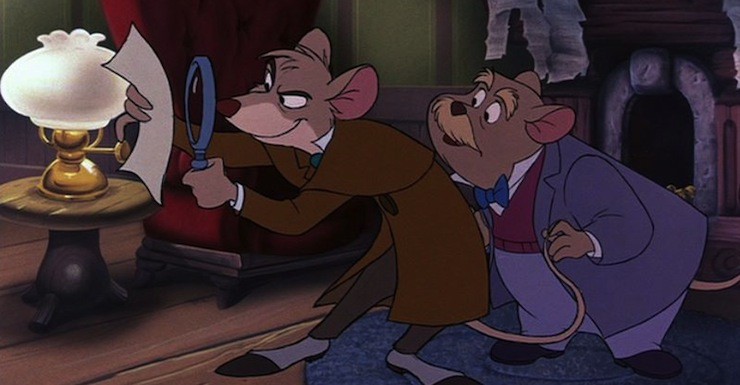

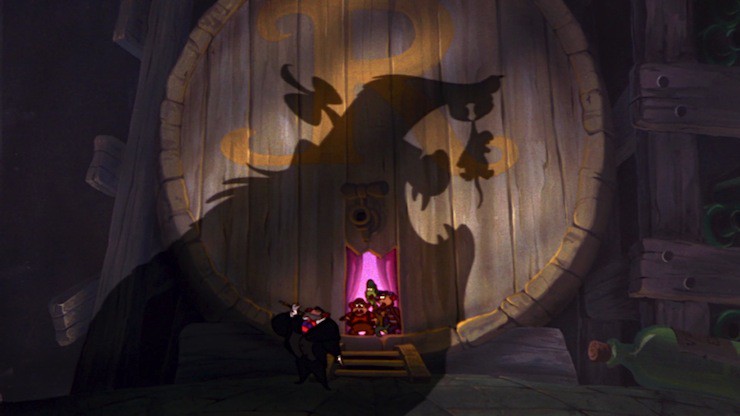
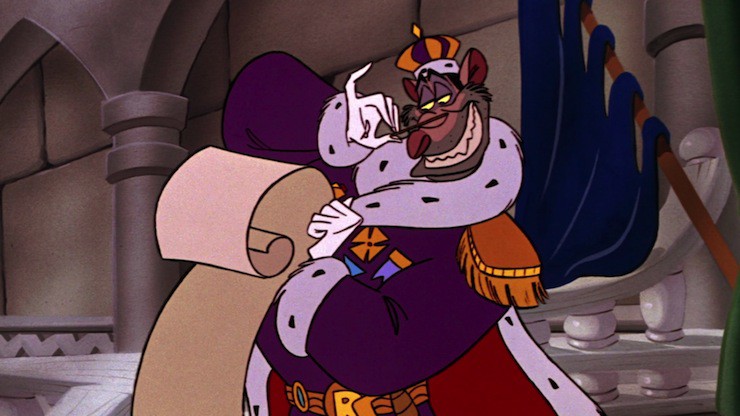
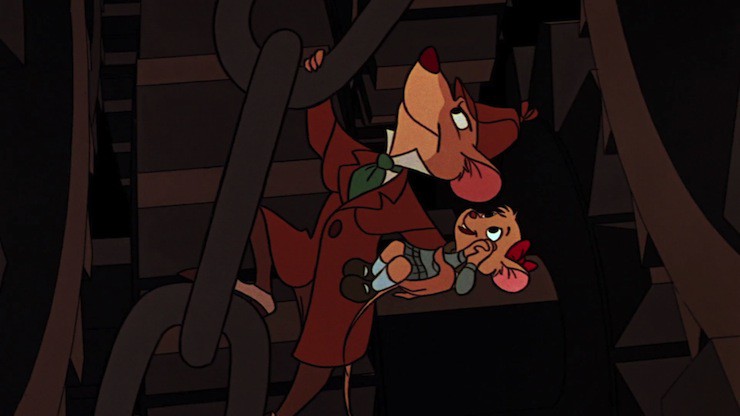
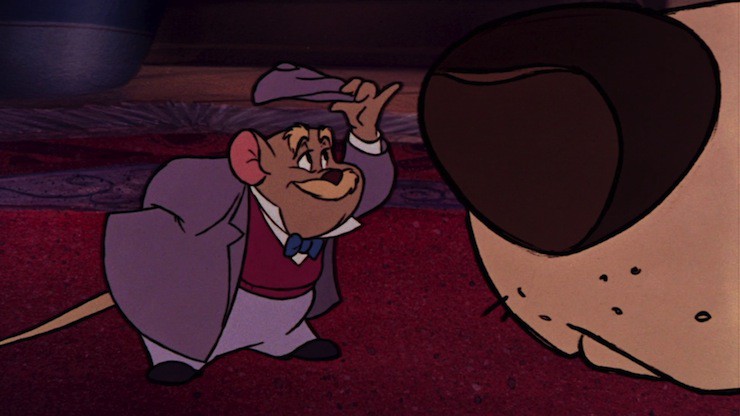
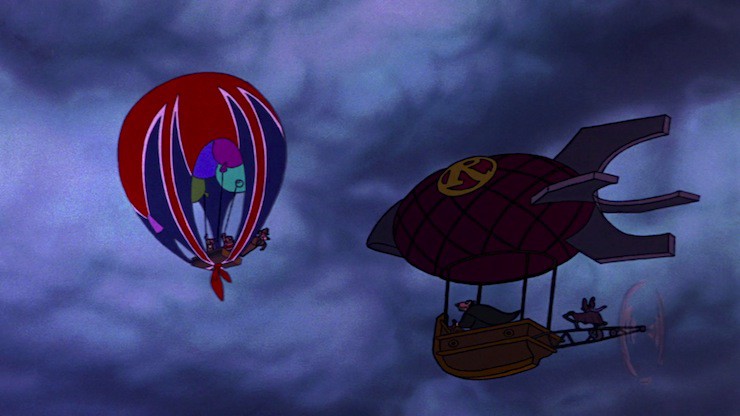
Now I’m trying to remember if I’ve ever actually seen this one or not … To Netflix!
I’ll admit, this one is pretty far down on my list of Disney films (I actually find Black Cauldron more entertaining). So I can’t think of much to say about it. Nothing about it is particularly bad; I’m just not that into the Sherlock Holmes/steampunky genres.
But it’s kind of fun that we are moving into territory that I remember in my living life! I actually don’t have any memories of Great Mouse Detective but I DO remember an American Tale very vividly! I was about 3.5 when both of these movies came out, so I probably don’t remember the actual promotions (in fact, it might be that some of the memories are from when Fievel Goes West was promoted). Looking at the dates, I suppose I was alive when Black Cauldron came out but I definitely have no memory of that.
That said, am I not mistaken in guessing the next one is Who Killed Roger Rabbit? I loved that movie as a kid, haha. I think it is technically not part of the Disney Animated Canon (at least not according to the lists I’ve seen) but…yay :)
Useless trivia: one of Mellisa Manchester’s first recording was on National Lampoon’s Radio Dinner album. She is the backup singer in ‘Deteriorata’ and plays Yoko in ‘Magical Misery Tour.’
It’s so weird how this series is revealing to me Disney’s downslide. This was my childhood, yet to my memory, Disney’s cartoons were always a part of them, Disney reigned supreme over everyone. I had all the older movies on VHS(remember those BIG PLASTIC CASES), so when Disney experienced their Renaissance with TLM, to me it was like they’d never gone away. Of course this wasn’t helped by the fact that I assumed EVERY animated movie was a Disney movie, like An American Tail and All Dogs Go To Heaven.
I can’t WAIT for Who Framed Roger Rabbit next week!
So, the first movie I seriously remember being hyped about was The Little Mermaid – and yeah, I had – and still do have – all those BIG PLASTIC CASES! And it’s interesting to me how that (along with the movies coming right after it) have really defined how I think of my childhood and Disney movies – all the spectacle and songs and all that. Combined with that was that I was a kid when they started really marketing the video sales of the ‘Classics’ – stuff like Cinderella and Sleeping Beauty and Snow White. So I missed a lot of the ‘duds’ (until I went back and watched them on my own) and it’s kind of interesting to see how many of them there are amongst the ‘classics’. As well as how few Disney movies actually are musicals.
I remember this film rather favorably both from childhood and as a nostalgic adult. As an adult, it’s clear there are few resemblances between Dawson and Watson, and Basil is decidedly a flat character. However, as a child, I had low expectations for Basil because I was familiar enough with the Holmes character to recognize the iconography. I didn’t expect a dynamic character. I also enjoyed Dawson, and was endeared to him because of his very “Rescuers” Disney empathy and moral character. One could look at his prudish refusal to cooperate during the bar scene and his inability to behave appropriately in a bar as an attempt to critique the scene itself, the way the cat eating the intoxicated mouse is supposed to criticize intoxication, so either Dawson is just a cute bumbling assistant (classic Disney) or the characterization was a was a caveat to avoid the PG rating–like many tactics employed by the Japanese to slip past the government censors. I found Olivia to be irritating filler. Vincent Price was a gem, and is perhaps, to this day, my favorite aspect of the film. As a small child, I recognized his voice immediately; having been brought up on classic cinema, Price’s role as Bakka the Master Builder in The Ten Commandments (and Irontail in the Bass/Rankin film Peter Cottontail) is at the forefront of even my absolute youngest childhood memories.
I still enjoy watching The Great Mouse Detective when the kids put it on. I know it’s not Aladdin or The Lion King, but it has a special place in my heart, and I’ll never say no to it.
Wow! I remember An American Tail at least all the marketing and the hit song that came from it. I don’t think I saw it in theaters. It seems years more modern The Great Mouse Detective detective though which feels like most of the previous films should have come out before I was born.
This is the first Disney animated film that I can remember seeing during my childhood and thus remember it quite favorably. To this day, I watch this film more readily than most other Disney animated classics. The animation was fun and very much in line with its time. My favorite scene, which sadly did not even receive a nod in the article, was the Rube Goldberg death trap. Some of the characters are a little cliche, but you could point that out for most others in the Disney collection.
I like The Great Mouse Detective more than most people do. I’m fond of Holmesiana (even more so when younger), enjoy the Victorian atmosphere, and like the toy store, the clockwork queen, and Fidget the bat trying to remember his list. Vincent Price is indeed the highlight–The World’s Greatest Criminal Mind. I enjoy the Rube Goldberg device Ratigan sets up to kill (overkill) Basil. Appropriately enough, it reminded me of the board game Mousetrap. I like the scene where Basil defeats the contraption.
I was glad there was a girl character who had spunk and loyal supporters, and who was not focused on romance, since I as a girl was not focused on romance. Nor did I particularly want to wear sparkly dresses. I found it easier to identify with Olivia than with the Disney princesses (who of course were not a marketing category yet). Once I went to a party where you were to dress as a favorite Disney movie character: my first choice was Madam Mim, and my second was Olivia. I liked the fact that Toby the dog listened to her, and not to Basil! Though since I was not able to take a giant dog with me to the party, I went for the purple hair.
Did anyone else notice that this is the first Disney movie to have a cross-dressing character? Sure, the bat dresses as a girl to trick our heroes, but then he keeps the clothes on long after there was an opportunity to take them off.
Also, this is one of Disney animation’s scariest movies to date. When I was little, I hated the jump scares with the bat; now, the part with the toy shop creeps me out. (Creepy dolls! Creepy baby dolls!- shudder-)
This one I never saw. My son had gotten too old to want to go to a Disney film with his dad, and as I recollect, the reviews were not so great. I will have to look it up one of these days and give it a try.
There’s been a persistent rumor that the animators’ inspiration for Ratigan was corporate raider Saul Steinberg, who was attempting a hostile takeover of Disney at that time.
Also, there was a lot of grumbling when the film’s title was “dumbed down” from “Basil of Baker Street” to “The Great Mouse Detective” on the grounds that audiences wouldn’t “get” the original title.
This led to the storymen issuing a mock memo purportedly from Disney management that all previous films would now be retitled; e.g., “Snow White” would be “The Girl and the Seven Little Men,” “Dumbo” would be “The Flying Baby Elephant,” etc.
I heard on a Disney podcast that the visual look for Ratigan was based on outgoing/former Disney CEO Ron Miller, who apparently wasn’t the kindest person to work for.
Also: “It enjoyed an only modest success at the box office, overshadowed by rival Don Bluth’s mouse film, An American Tail, a collaboration with Steven Spielberg, and a little in-house film that also briefly featured a mouse, also a collaboration with Steven Spielberg.”
What is the second movie referenced here? I assume it’s Who Framed Roger Rabbit? Didn’t that release two years after The Great Mouse Detective? How did Roger overshadow Detective? I don’t even think the target audience was the same…I remember seeing both An American Tail and The Great Mouse Detective in theaters, but my parents wouldn’t take me to see Who Framed Roger Rabbit, presumably because of Jessica. I always assumed that Roger skewed toward a more teen/adult audience, despite the use of cartoon characters.
Plus music by Henry Mancini.
Perhaps his last movie sound track.
Never saw this one. I was 21, and in the Army when it came out, so I wasn’t even taking a girlfriend’s little brother along with. Did see An American Tail, because the animation was reported to be topnotch.
What was the second little movie that competed with this?
Watson doesn’t start the stories married, nor is he married only once. He had quite an eye for the ladies as well :)